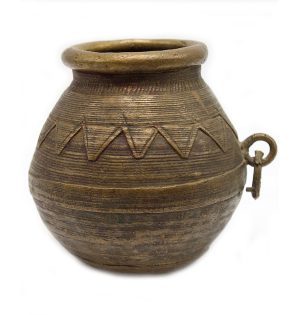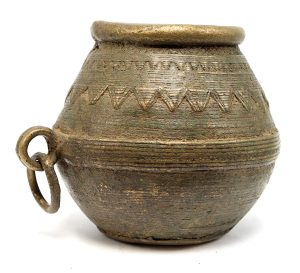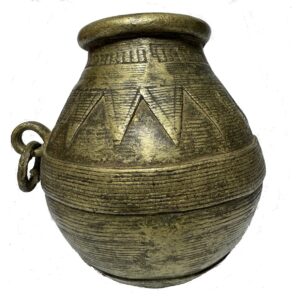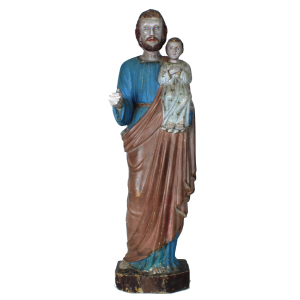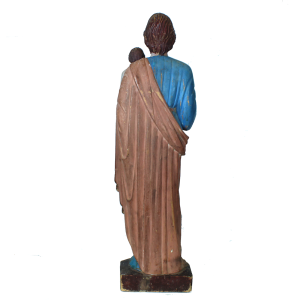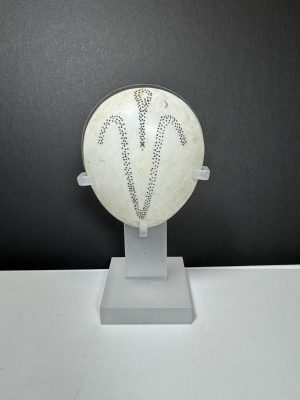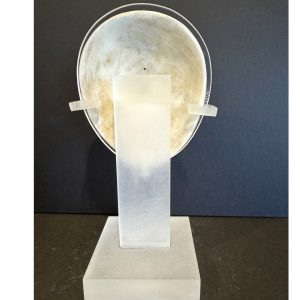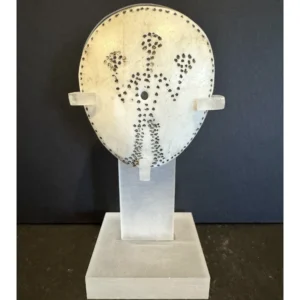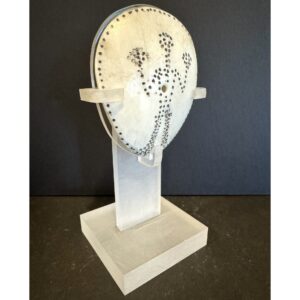-


$155.00
H: 3.875” Dia: 3.875” | FREE SHIPPING IN CONTINENTAL U.S.!
This antique brass vessel was a daily measuring bowl for rice or other grains made by Dhokra metalsmiths from Eastern India using the same lost wax casting process for millennia. Extremely labor intensive and time consuming, each piece is one-of-a-kind. Dhokra items are beautifully and intricately decorated with simple uncomplicated forms. This charming piece is a typical grain measure and has a handle for hanging and decorated with horizontal striations across the top and bordered by downward striated triangles with a smooth patina from age and use. This bowl were regarded as a symbol of the Hindu goddess Lakshmi and was prized by villagers who could afford them for puja home worship and placed on a home altar.
Click here for the Blog Dhokra Metal Smiths: Retaining Primitive Techniques with Unfailing Success
Click here for the Blog Hindu Home and Temple Shrines and Religious Practices
-


$155.00
H: 3.5” Dia: 3.75” | FREE SHIPPING IN CONTINENTAL U.S.!
This antique brass vessel was a daily measuring bowl for rice or other grains made by Dhokra metal smiths from Eastern India using the same lost wax casting process for over 4000 years. Extremely labor intensive and time consuming, each piece is one-of-a-kind. Dhokra items are beautifully and intricately decorated with simple uncomplicated forms. This charming piece has a handle for hanging with horizontal striations and downward striated triangles with a smooth patina from age and use. This type of bowl was regarded as a symbol of the Hindu goddess Lakshmi and was prized by villagers who could afford them for puja home worship and placed on a home altar.
-

$155.00
H: 3.875” Dia: 4.125” | FREE SHIPPING IN CNTINENTAL U.S.!
This antique brass vessel was a daily measuring bowl for rice or other grains made by Dhokra metal smiths from Eastern India using the same lost wax casting process for over 4000 years. Extremely labor intensive and time consuming, each piece is one-of-a-kind. Dhokra items are beautifully and intricately decorated with simple uncomplicated forms. This charming piece has a handle for hanging with horizontal striations and downward striated triangles with a smooth patina from age and use. This type of bowl was regarded as a symbol of the Hindu goddess Lakshmi and was prized by villagers who could afford them for puja home worship and placed on a home altar.
-


$155.00
H: 4.25” Dia: 4” | FREE SHIPPING IN CONTINENTAL U.S.!
This antique brass vessel was a daily measuring bowl for rice or other grains made by Dhokra metal smiths from Eastern India using the same lost wax casting process for over 4000 years. Extremely labor intensive and time consuming, each piece is one-of-a-kind. Dhokra items are beautifully and intricately decorated with simple uncomplicated forms. This charming piece has handle for hanging with horizontal striations and downward striated triangles with a smooth patina from age and use. This type of bowl was regarded as a symbol of the Hindu goddess Lakshmi and was prized by villagers who could afford them for puja home worship and placed on a home altar.
-


$155.00
H: 3.75” Dia: 3.75” | FREE SHIPPING IN CONTINENTAL U.S.!
This antique brass vessel was a daily measuring bowl for rice or other grains made by Dhokra metal smiths from Eastern India using the same lost wax casting process for over 4000 years. Extremely labor intensive and time consuming, each piece is one-of-a-kind. Dhokra items are beautifully and intricately decorated with simple uncomplicated forms. This charming piece has a handle for hanging with horizontal striations and downward striated triangles with a smooth patina from age and use. This type of bowl was regarded as a symbol of the Hindu goddess Lakshmi and was prized by villagers who could afford them for puja home worship and placed on a home altar.
-
Sale!


$4,800.00 Original price was: $4,800.00.$3,300.00Current price is: $3,300.00.
H: 29.5″ W:7.75″ D:5.25″ | CALL 213-568-3030 OR EMAIL [email protected] FOR SHIPPING.
This rare magnificent carving of Joseph with the Christ child from Kerala reflects a blend of Portuguese and European traditions with the indigenous traditions of South India. Joseph stands in an altered European contrapposto pose, light-skinned, blue-eyed, with western features. As the earthly father and patron saint of workers, he wears a modest burnt-umber shawl. Exquisitely carved, he is the embodiment of simple spirituality.
-
Sale!


$250.00 Original price was: $250.00.$195.00Current price is: $195.00.
H: 5.25″ W:3.75 ” D: 2 ” | FREE SHIPPING WITHIN CONTINENTAL U.S.
Made by the Naga, a collection of tribal ethnic groups in India with a similar culture including a headhunting tradition in its past, conch shell ear covers are worn by men and attached to pierced ears through a hole in the shell. They are usually decorated stippled abstract images of curved buffalo horns with the buffalo’s neck and head inside the V-shaped horns. Mounted on a lucite base, they are an interesting example of unique cultural art,.
-
Sale!


$225.00 Original price was: $225.00.$195.00Current price is: $195.00.
H: 4.6″ W:2.5 ” D: 2.12 ” | FREE SHIPPING WITHIN CONTINENTAL U.S.!
Made by the Naga, a collection of tribal ethnic groups in India with a similar culture including a headhunting tradition in its past, conch shell ear covers are worn by men and attached to pierced ears through a hole in the shell. They are often decorated stippled abstract images of standing human figures with raised arms and hands and spread fingers Mounted on a lucite base, they are an interesting example of unique cultural art,.
End of content
End of content

